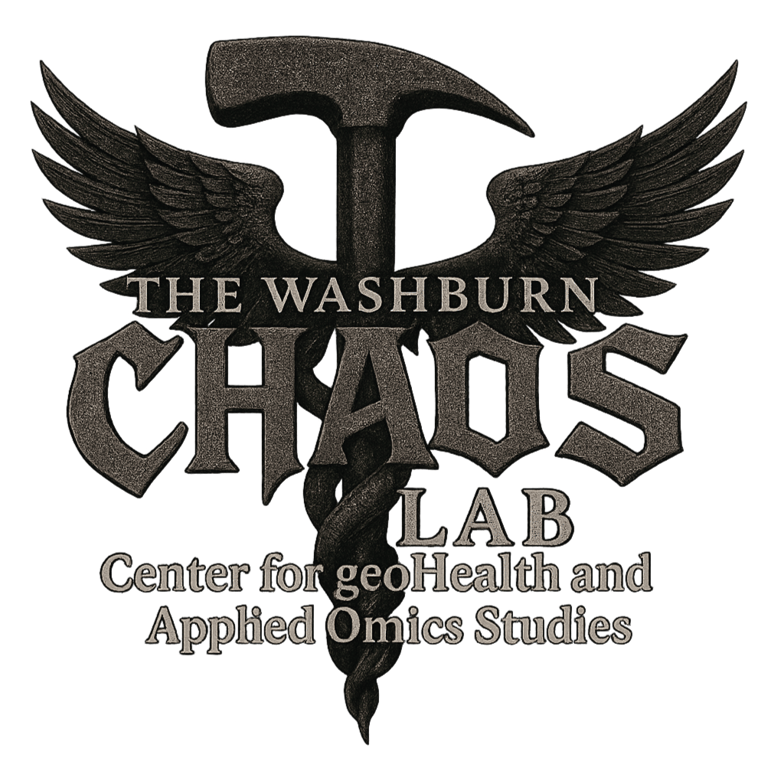What Does CHAOS Lab Actually Do? (Glad You Asked)
At CHAOS Lab, we don’t do tidy science—we do feral, interdisciplinary field science at the edge of environmental chaos and human health. We dig into geogenic and anthropogenic contaminants (aka what leaks out of rocks and wrecks your organs), unravel the health impacts of disasters and unstable terrain, chase down wild geo-biological interactions in extreme environments, and conduct large-scale geospatial microbiome surveillance like microbial special ops. It’s geology meets biomedicine with a side of omics, field grit, and tactical sequencing.
RESEARCH FEATURECHAOS VIBESFERAL SCIENCECUTTING EDGE CHAOSBIOPROSPECTINGEXTREME ECOSYSTEMSNATURAL DISASTERSLAB OPSDATA WITH IMPACTCORNERSTONE OF CHAOSCAVE & KARSTBADASS MICROBESFIELD OPS
6/25/20253 min read
We get asked this a lot. Usually with a raised eyebrow, some concern about the skull mug, and at least one person nervously glancing at the microwave marked “DO NOT HEAT ANYTHING FROM FREEZER 7.” Fair question. Here’s the answer:
We are The Washburn CHAOS Lab—the Center for GeoHealth and Applied Omics Studies—and we study the intersection of geoscience and human health.
That’s the short version. The longer version? We are unapologetically, irreversibly, and proudly interdisciplinary.
What does “interdisciplinary” mean?
It means we don’t stay in one lane. Our science crosses boundaries—because the world does too. We integrate geology, biomedicine, atmospheric science, microbiology, geochemistry, biology, ecology, toxicology, biochemistry, stratigraphy, geospatial analysis, bioinformatics, geoinformatics, chemistry, and pharmacology. And we do it all at once.
The Washburn CHAOS Lab recognizes a simple truth: science doesn’t fit into neat little boxes, and neither does the world. Extreme weather doesn’t care about academic disciplines. Microbes don’t follow departmental boundaries. And disease? Disease shows up wherever conditions allow it—across soil, water, air, and time.
Everything interacts with everything else. So, to understand what’s happening—and what we can do about it—we look at the big picture first, then zoom in to answer relevant, urgent, and specific questions.
So yeah. We’re very interdisciplinary. And what we do is break silos, follow the science, and embrace the chaos.
Here are the Four Cornerstones of CHAOS—our four research divisions that hold the lab together.
1. Geogenic and Anthropogenic Contaminants
Codename: TOXCAST Division (Toxicological Contaminant Assessment & Stratigraphic Tracking)
This is where we study and track what leaks out of rocks and human mistakes. From arsenic to nitrates to heavy metals, we study how geologic processes and industrial activity mobilize toxic substances—and how microbes respond, resist, adapt, or fight back.
It's part bioindicator surveillance, part geochemical crime scene investigation.
2. Health Impacts of Natural Disasters, Extreme Weather, and Landscape Instability
Codename: DISRUPT Division (Disaster-Induced Shifts in Resilience, Unrest, Pathogens, and Terrain)
When Earth has a meltdown—wildfires, floods, landslides—we roll out. This division studies microbial and environmental shifts before, during, and after disasters. We monitor health risks, ecosystem collapse, and how terrain instability affects pathogen movement.
If the land shifts or burns, we want to know what the microbes do next.
3. Geo-Biological Interactions and Resource Potential
Codename: BIOFORGE Unit (Bioprospecting and Investigation of Organisms for Resource Generation and Extraction)
This is our molecular treasure hunt. We explore caves, mines, post-disaster zones—anywhere geology gets weird and life fights to survive. We're looking for unique microbes, strange biochemistry, and novel molecules that might help clean up contamination, fight disease, or inspire the next bioengineered breakthrough.
Extremes forge resilience—and that’s exactly what we study.
4. Large-Scale Geospatial Microbiome Surveillance Across Diverse Geologic Frameworks
Codename: Microbial ISR Division (Intelligence, Surveillance, and Reconnaissance of Microbial Systems)
This is tactical microbiology. We map microbial life across aquifers, rock formations, and time to understand how communities shift in response to stress. Using geoinformatics, spatial analysis, and omics tech, we identify hotspots for emerging pathogens and biologically active zones for future exploration.
It’s long-range recon, but for microbes.
And Beyond the Lab: Science for Everyone
We don’t just do research in vacuum-sealed academic towers. CHAOS Lab is committed to community outreach, education, and collaboration. We believe anyone can do science—and we’re here to show that you don’t need a PhD to be curious, engaged, and impactful.
Whether you’re a high school student, a veteran, a farmer, or just someone who’s into weird rocks and cooler microbes, you belong here. We offer research and learning opportunities, support citizen science, and host events that blend outreach with pure scientific chaos—because science should be honest, powerful, and fun.
TL;DR?
We study chaos:
🔬 What leaks from rocks and ruins
🔥 How disasters reshape life
🧬 Where biology and geology collide
🛰️ And how to track it all, everywhere
We are the CHAOS Lab. Interdisciplinary by nature. Feral by choice.
Science should be metal AF.


Extreme Earth. Extreme microbes. Extreme science.
